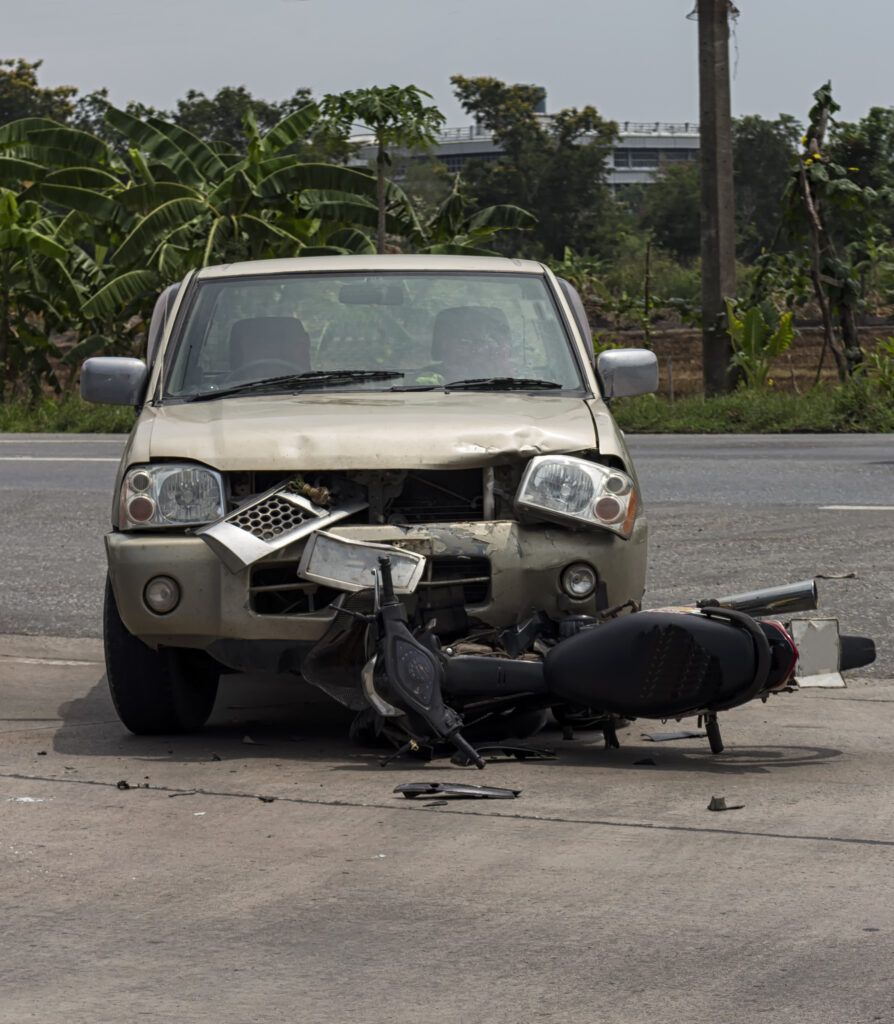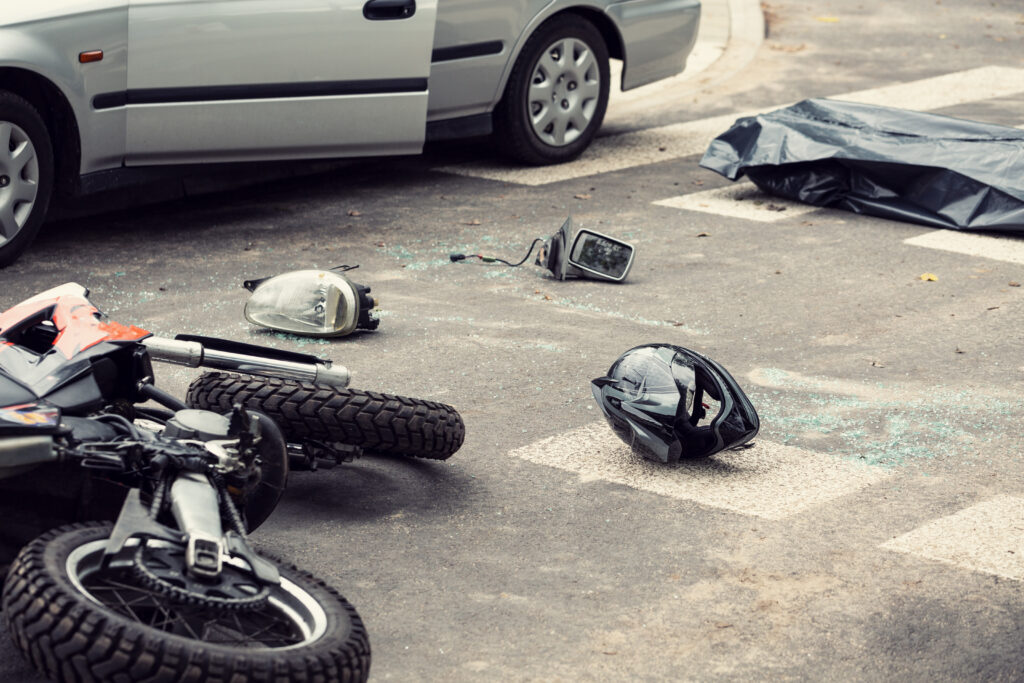Common Causes of Motorcycle Accidents in Pennsylvania
Motorcycle accidents, particularly in Pennsylvania, can occur due to a variety of reasons. While driver inattention is the most frequent cause of a motorcycle accident, speeding, road conditions, or even weather could contribute to a potentially fatal accident. Understanding the common causes of motorcycle accidents is important so that motorcycle riders can learn to prevent them. Contact an experienced motorcycle accident lawyer at PhillyLaw for a free consultation to learn your rights if you or a loved one has been injured or died as a result of a motorcycle accident.

Driver Inattention is the Most Common Cause of Motorcycle Accidents
This includes both motorcyclists and automobile drivers failing to notice each other, especially at intersections, due to a lack of proper observation or distractions such as mobile phone use. The smaller profile of motorcycles makes them less visible to car drivers, increasing the risk of collision when others on the road are not paying close attention.
Speeding
Exceeding speed limits or riding too fast for conditions is a leading factor in motorcycle crashes, reducing reaction time and increasing the severity of crashes. Speeding exacerbates the risk of motorcycle accidents by significantly diminishing the rider’s ability to react to unexpected obstacles or changes in road conditions. At higher speeds, the distance required to stop a motorcycle increases, making it more challenging to avoid collisions with vehicles, pedestrians, or obstacles.
Additionally, speeding increases the likelihood of losing control, especially around curves or during sudden maneuvers, leading to more severe accidents. The increased impact force at higher velocities can result in more serious injuries or fatal crashes, underlining the critical importance of adhering to speed limits and riding at safe speeds.
Visibility Issues
Motorcycles are less visible to other drivers, especially at intersections or during low light conditions, leading to accidents. Visibility issues significantly impact motorcycle accidents by increasing the likelihood of collisions. Motorcycles’ smaller size and profile make them less noticeable on the road compared to larger vehicles. This lack of visibility is particularly problematic at intersections or during night-time and adverse weather conditions when the ability to see and be seen is further compromised.
Lane Splitting
Lane splitting, a topic often surrounded by debate, refers to the practice where a motorcyclist rides between lanes of stopped or slowly moving cars, typically during traffic jams. This maneuver is seen as a way to bypass congestion, but it is considered illegal in many jurisdictions due to safety concerns.
Lane splitting can lead to motorcycle accidents in several ways, primarily due to the reduced space for maneuvering and the close proximity to vehicles traveling in adjacent lanes. When motorcyclists navigate between lanes of slow-moving or stopped traffic, they often have little room to avoid sudden obstacles or respond to unexpected actions from car drivers, such as opening a door or changing lanes without notice. Additionally, drivers may not anticipate or see a motorcycle moving through traffic in this manner, leading to a motorcycle crash if they attempt to shift lanes or if their attention is momentarily diverted. The inherently reduced visibility and reaction time in lane-splitting scenarios make it a high-risk activity, contributing to the potential for accidents.
Sudden Stops
Rear-end accidents can occur when a vehicle abruptly stops in front of a motorcycle, often because motorcycles have a shorter stopping distance compared to cars.
Sudden stops are particularly hazardous for motorcyclists due to the intrinsic dynamics and braking capabilities of motorcycles. When a vehicle ahead stops abruptly, the motorcyclist may not have sufficient time or distance to react and stop safely, leading to a potential rear-end collision. Unlike cars, motorcycles are less stable during emergency braking, especially if the surface is wet or uneven, increasing the risk of skidding or the rider being thrown off the bike. Additionally, if the motorcyclist swerves to avoid hitting the vehicle, they might collide with other obstacles or vehicles on the road. The difference in stopping distances between motorcycles and larger vehicles can catch motorcyclists by surprise, emphasizing the need for greater following distances and heightened awareness of the surrounding traffic to mitigate the risk of accidents due to sudden stops.
Left-Turn Accidents
These accidents happen when a vehicle making a left turn fails to see an oncoming motorcycle or misjudges its speed, resulting in a collision.
Left-turn accidents involving motorcycles often result from a combination of visibility issues and misjudgment of speed or distance by the turning driver. Typically, these accidents happen at intersections where a vehicle attempts to turn left across the path of an oncoming motorcycle. As a result, the motorcyclist is often left with little time to react, resulting in a collision that can cause significant injuries or fatalities.
Road Hazards
Road hazards are especially perilous for motorcyclists due to the inherent stability challenges of motorcycles. Unlike cars, which have four contact points with the ground, motorcycles only have two, making them much more sensitive to variations in road surface conditions. Potholes, gravel, wet or slippery surfaces, debris, and other irregularities can drastically alter the grip a motorcycle tire has with the road. When a motorcyclist encounters such hazards, it can lead to a loss of control, causing the motorcycle to wobble, skid, or even crash. The rider’s ability to safely navigate these hazards is also heavily dependent on their skill level, reaction time, and the motorcycle’s tire condition. Even minor road irregularities that would be inconsequential to a car can pose a significant threat to motorcyclists, often leading to serious injuries resulting from the motorcycle accident or even a fatal accident.
Impaired Driving
Operating a motorcycle or another vehicle under the influence of alcohol or drugs drastically increases the risk of an accident due to impaired judgment and reduced motor function causing reckless driving.
Impaired driving, resulting from alcohol or drug use, significantly elevates the risk of accidents for motorcyclists by diminishing the rider’s cognitive functions and physical coordination. Alcohol and drugs impair judgment, delay reaction times, and reduce the motorist’s ability to make quick decisions in dynamic traffic scenarios. For motorcyclists, who rely heavily on balance, precision, and quick reflexes to operate safely, even a slight impairment can lead to catastrophic consequences. The effects of alcohol or drugs can lead to overconfidence, making riders less cautious and more likely to take unnecessary risks, such as speeding or engaging in erratic maneuvers. Furthermore, impaired motorcyclists may find it difficult to judge distances and speeds accurately, negotiate turns, or avoid obstacles. This compromises not only their safety but also that of others on the road, significantly increasing the likelihood of an accident.
Motorcycle Defects and Accidents
Motorcycle defects can indeed serve as a critical factor leading to accidents, further underlining the importance of regular maintenance and thorough inspections. Manufacturing flaws or mechanical failures such as brake malfunctions, tire defects, or issues with the steering mechanism can drastically impair a rider’s ability to control their motorcycle. These defects not only pose a severe risk to the motorcyclist but can also endanger other road users. Ensuring that motorcycles are free from defects and are regularly serviced is crucial to promoting road safety and preventing accidents.
Understanding these common causes is crucial for both motorcyclists and car drivers to take protective measures and ensure safer roads for everyone.

Motorcycle Accidents are More Likely to Lead to a Fatality
The grim reality is that reported motorcycle crashes result in a disproportionate number of fatalities compared to automobile collisions. A motorcycle rider lacks the protective enclosure that cars provide, exposing them to the full force of impact in the event of a collision. Furthermore, motorcycles are less stable than four-wheeled vehicles during emergency braking and maneuvering, which contributes to a higher risk of deadly accidents. The National Highway Traffic Safety Administration (NHTSA) statistics reveal that per vehicle mile traveled, motorcyclists are about 24 times more likely than passenger car occupants to die in a traffic crash. This stark statistic underscores the critical need for enhanced safety awareness, the utilization of protective gear, and adherence to traffic laws among the motorcycling community.
Despite wearing protective gear such as helmets, the motorcyclist’s body is still vastly exposed to direct impact forces, road surfaces, and other vehicles. According to safety studies and crash statistics, motorcyclists are approximately 29 times more likely than passenger car occupants to suffer fatal injuries in a road traffic accident, per vehicle miles traveled. This stark disparity underscores the critical need for both riders and drivers to exercise heightened caution and respect on the roads, aiming to reduce these tragic outcomes.
Head-On Collisions
Head-on collisions represent one of the most dangerous types of accidents for motorcyclists, often resulting in severe injuries or fatalities. These accidents typically occur when a vehicle crosses into the opposing lane of traffic, directly impacting the motorcycle. Due to the high relative speeds and the direct force of impact associated with head-on collisions, the motorcyclist has minimal protection against the full brunt of the crash. Even with protective gear such as helmets and body armor, the sheer force can cause catastrophic injuries. The lack of structural protection around the motorcyclist, unlike the enclosed space of a car, amplifies the severity of these accidents often leading to fatal accidents. Consequently, head-on collisions pose a significant threat to motorcyclists, strongly emphasizing the need for vigilant and defensive riding practices.

How Motorcycle Riders Can Avoid Motorcycle Crashes
Motorcycle riders can significantly reduce the risk of crashes through vigilant riding, continuous education, and proper gear usage. First and foremost, attending a motorcycle safety course is essential for learning the best practices in riding techniques and road safety. Furthermore, being constantly aware of your surroundings and anticipating the actions of other road users can prevent accidents.
Using defensive riding strategies, such as maintaining a safe distance from vehicles, signaling intentions early, and avoiding riders’ blind spots, is critical. Equally important is wearing appropriate safety gear, including a DOT-approved helmet, protective clothing, gloves, and boots, which can drastically reduce injury severity during a crash. The simple act of wearing a helmet can reduce the possibility of head injuries. Regular maintenance checks are also vital to ensure the motorcycle is in optimal condition, focusing on critical components like brakes, tires, and lights. Adhering to traffic laws, riding sober, and avoiding speeding can further diminish the chances of being involved in an accident. By implementing these strategies, motorcycle riders can enjoy a safer riding experience on the roads and avoid potentially fatal motorcycle accidents.
Our Commitment to Motorcycle Riders
At PhillyLaw, we understand the unique challenges and risks motorcycle riders face every day on the road. Our dedicated team of experienced motorcycle accident lawyers is committed to protecting the rights of motorcyclists and fighting for the justice they deserve. In the unfortunate event of an accident, it’s crucial to have knowledgeable legal representation on your side. Our lawyers have a deep understanding of the complexities involved in motorcycle accident cases and are equipped to provide the comprehensive support and guidance needed to navigate the legal process. If you have been injured in a motorcycle accident or a loved one has died as a result of a fatal accident, do not hesitate to contact PhillyLaw for a free consultation. We are here to help you recover the compensation you are entitled to.
